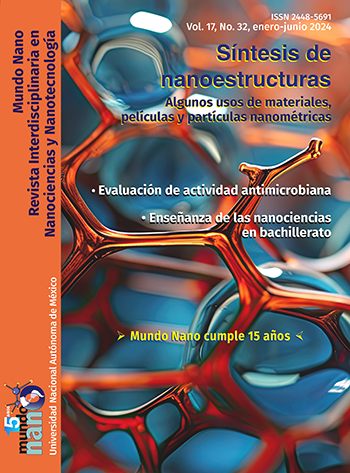Biosíntesis de nanopartículas de plata con actividad antimicrobiana por Pseudomonas aeruginosa ambiental
Conteúdo do artigo principal
Resumo
Las nanopartículas de plata (NPs-Ag) son de gran interés debido a las aplicaciones potenciales en diferentes áreas. En busca de metodologías que no presenten riesgos a la salud y sean amigables con el ambiente, la biosíntesis de nanopartículas ha sido una opción viable. Se sabe que diversas biomoléculas presentes en los microrganismos pueden tener las funciones de agente oxidante, reductor y estabilizador, favoreciendo la formación de nanopartículas. En el presente trabajo se tuvo como objetivo la biosíntesis, caracterización y evaluación de la actividad antibacteriana de NPs-Ag. La biosíntesis se realizó a partir de sobrenadante de un cultivo de Pseudomonas aeruginosa, las nanopartículas se caracterizaron mediante espectroscopía UV-VIS, microscopía electrónica de barrido y difracción de rayos X, y la actividad antibacteriana se evaluó con ensayos de dilución en caldo Mueller Hinton, se determinó la concentración mínima inhibitoria (CMI) y concentración mínima bactericida (CMB) sobre bacterias Gram positivas y negativas. Se encontró que la mejor síntesis fue con una mezcla de 20% de sobrenadante conteniendo 3 mM de AgNO3, observando nanoestructuras con morfologías mixtas. Presentaron actividad contra bacterias Gram positivas y negativas con CMI de 1 a 2 µg/ml y CMB de 2 a 4 µg/ml. En conclusión, el sobrenadante de cultivos de P. aeruginosa es una alternativa viable para la síntesis de NPs-Ag con actividad antibacteriana.
Downloads
Detalhes do artigo

Mundo Nano. Revista Interdisciplinaria en Nanociencias y Nanotecnología, editada por la Universidad Nacional Autónoma de México, se distribuye bajo una Licencia Creative Commons Atribución-NoComercial 4.0 Internacional.
Basada en una obra en http://www.mundonano.unam.mx.
Referências
Amendola, V., Bakr, O. M. y Stellacci, F. (2010) A study of the surface plasmon resonance of silver nanoparticles by the discrete dipole approximation method: Effect of shape, size, structure, and assembly. Plasmonics, 5: 85-97. https://doi.org/10.1007/s11468-009-9120-4. DOI: https://doi.org/10.1007/s11468-009-9120-4
Durán, N., Durán, M., De Jesús, M. B., Seabra, A. B., Fávaro, W. J. y Nakazato, G. (2016). Silver nanoparticles: a new view on mechanistic aspects on antimicrobial activity. Nanomedicine: Nanotechnology, Biology and Medicine, 12(3): 789-799. https://doi.org/10.1016/j.nano.2015.11.016. DOI: https://doi.org/10.1016/j.nano.2015.11.016
Filloux, A. (2011). Protein secretion systems in Pseudomonas aeruginosa: an essay on diversity, evolution, and function. Frontiers in Microbiology, 2, 155.x. https://doi.org/10.3389/fmicb.2011.00155. DOI: https://doi.org/10.3389/fmicb.2011.00155
Flores-Pantoja, L. E., Briseño-Silva, E, Loeza-Lara, P. D. y Jiménez-Mejía, R. (2022). Actividad antifúngica y características de promoción de crecimiento vegetal de Pseudomonas aeruginosa y Enterobacter sp. degradadoras de hidrocarburos aisladas de suelo contaminado. Acta Biológica Colombiana, 27(3). https://doi.org/10.15446/abc.v27n3.92758. DOI: https://doi.org/10.15446/abc.v27n3.92758
Franci, G., Falanga, A., Galdiero, S., Palomba, L., Rai, M., Morelli, G. y Galdiero, M. (2015). Silver nanoparticles as potential antibacterial agents. Molecules, 20(5): 8856-8874. https://doi.org/10.3390/molecules20058856. DOI: https://doi.org/10.3390/molecules20058856
Gul, S., Ismail, M., Khan, M. I., Khan, S. B., Asiri, A. M., Rahman, I. U., Kahn, M. A. y Kamboh, M. A. (2016). Novel synthesis of silver nanoparticles using melon aqueous extract and evaluation of their feeding deterrent activity against housefly Musca domestica. Asian Pacific Journal of Tropical Disease, 6(4): 311-316. https://doi.org/10.1016/S2222-1808(15)61036-2. DOI: https://doi.org/10.1016/S2222-1808(15)61036-2
Huq, M. (2020). Green synthesis of silver nanoparticles using Pseudoduganella eburnea MAHUQ-39 and their antimicrobial mechanisms investigation against drug resistant human pathogens. International Journal of Molecular Sciences, 21(4): 1510. https://doi.org/10.3390/ijms21041510. DOI: https://doi.org/10.3390/ijms21041510
Huq, M. A., Ashrafudoulla, M., Rahman, M. M., Balusamy, S. R. y Akter, S. (2022). Green synthesis and potential antibacterial applications of bioactive silver nanoparticles: a review. Polymers, 14(4), 742. https://doi.org/10.3390/polym14040742. DOI: https://doi.org/10.3390/polym14040742
Iravani, S. (2014). Bacteria in nanoparticle synthesis: current status and future prospects. International Scholarly Research Notices, 2014. https://doi.org/10.1155/2014/359316. DOI: https://doi.org/10.1155/2014/359316
Khan, I., Saeed, K. y Khan, I. (2017). Nanoparticles: properties, applications and toxicities. Arabian Journal of Chemistry, 12: 908-931. https://doi.org/10.1016/j.arabjc.2017.05.011. DOI: https://doi.org/10.1016/j.arabjc.2017.05.011
Kim, S. W., Chung, H. E., Kwon, J. H., Yoon, H. G. y Kim, W. (2010) Facile synthesis of silver chloride nanocubes and their derivatives. Bulletin of the Korean Chemical Society; 31: 2918-22. https://doi.org/10.5012/bkcs.2010.31.10.2918. DOI: https://doi.org/10.5012/bkcs.2010.31.10.2918
Kumar, C. G. y Mamidyala, S. K. (2011). Extracellular synthesis of silver nanoparticles using culture supernatant of Pseudomonas aeruginosa. Colloids and Surfaces B:Biointerfaces, 84(2): 462-466. https://doi.org/10.1016/j.colsurfb.2011.01.042. DOI: https://doi.org/10.1016/j.colsurfb.2011.01.042
Kumar, C. G., Mamidyala, S. K., Das, B., Sridhar, B., Devi, G. S. y Karuna, M. S. (2010). Synthesis of biosurfactant-based silver nanoparticles with purified rhamnolipids isolated from Pseudomonas aeruginosa BS-161R. Journal of Microbiology and Biotechnology, 20(7): 1061-8. https://doi.org/10.4014/jmb.1001.01018. DOI: https://doi.org/10.4014/jmb.1001.01018
Madani, M., Hosny, S., Alshangiti, D. M., Nady, N., Alkhursani, S. A., Alkhaldi, H., Al-Gahtany, S. A., Ghobashy, M. M. y Gaber, G. A. (2022). Green synthesis of nanoparticles for varied applications: Green renewable resources and energyefficient synthetic routes. Nanotechnology Reviews, 11(1): 731-759. https://doi.org/10.1515/ntrev-2022-0034. DOI: https://doi.org/10.1515/ntrev-2022-0034
Naganthran, A., Verasoundarapandian, G., Khalid, F. E., Masarudin, M. J., Zulkharnain, A., Nawawi, N. M., Karim, M., Che Abdullah, C. A. y Ahmad, S. A. (2022). Synthesis, characterization and biomedical application of silver nanoparticles. Materials, 15(2): 427. https://doi.org/10.3390/ma15020427. DOI: https://doi.org/10.3390/ma15020427
Pantidos, N. y Horsfall, L. E. (2014). Biological synthesis of metallic nanoparticles by bacteria, fungi and plants. Journal of Nanomedicine and Nanotechnology, 5(5): 1. http://dx.doi.org/10.4172/2157-7439.1000233. DOI: https://doi.org/10.4172/2157-7439.1000233
Rabiee, N., Ahmadi, S., Akhavan, O. y Luque, R. (2022). Silver and gold nanoparticles for antimicrobial purposes against multi-drug resistance bacteria. Materials, 15(5): 1799. https://doi.org/10.3390/ma15051799. DOI: https://doi.org/10.3390/ma15051799
Rai, M. K., Deshmukh, S. D., Ingle, A. P. y Gade, A. K. (2012). Silver nanoparticles: the powerful nanoweapon against multidrug‐resistant bacteria. Journal of Applied Microbiology, 112(5): 841-852. https://doi.org/10.1111/j.1365-2672.2012.05253.x. DOI: https://doi.org/10.1111/j.1365-2672.2012.05253.x
Restrepo, C. V. y Villa, C. C. (2021). Synthesis of silver nanoparticles, influence of capping agents and dependence on size and shape: A review. Environmental Nanotechnology, Monitoring & Management, 15, 100428. https://doi.org/10.1016/j.enmm.2021.100428. DOI: https://doi.org/10.1016/j.enmm.2021.100428
Rudramurthy, G. R., Swamy, M. K., Sinniah, U. R. y Ghasemzadeh, A. (2016). Nanoparticles: alternatives against drug-resistant pathogenic microbes. Molecules, 21(7): 836. https://doi.org/10.3390/molecules21070836. DOI: https://doi.org/10.3390/molecules21070836
Sharma, V. K., Yngard, R. A. y Lin, Y. (2009). Silver nanoparticles: green synthesis and their antimicrobial activities. Advances in Colloid and Interface Science, 145(1-2): 83-96. https://doi.org/10.1016/j.cis.2008.09.002. DOI: https://doi.org/10.1016/j.cis.2008.09.002
Siddiqi, K. S., Husen, A. y Rao, R. A. (2018). A review on biosynthesis of silver nanoparticles and their biocidal properties. Journal of Nanobiotechnology, 16(1): 14. https://doi.org/10.1186/s12951-018-0334-5. DOI: https://doi.org/10.1186/s12951-018-0334-5
Singh, H., Du, J., Singh, P. y Yi, T.H. (2018). Extracellular synthesis of silver nanoparticles by Pseudomonas sp. THG-LS1.4 and their antimicrobial application. Journal of Pharmaceutical Analysis, 8: 258-264. https://doi.org/10.1016/j.jpha.2018.04.004. DOI: https://doi.org/10.1016/j.jpha.2018.04.004
Singh, P., Kim, Y. J., Zhang, D. y Yang, D. C. (2016). Biological synthesis of nanoparticles from plants and microorganisms. Trends in Biotechnology, 34(7): 588-599. https://doi.org/10.1016/j.tibtech.2016.02.006. DOI: https://doi.org/10.1016/j.tibtech.2016.02.006
Tada, S., Watanabe, F., Kiyota, K., Shimoda, N., Hayashi, R., Takahashi, M., Nariyuki, A., Igarashi, A., Satokawa, S. (2017). Ag addition to CuO-ZrO2 catalysts promotes methanol synthesis via CO2 hydrogenation. Journal of Catalysis. 351 (2017): 107-118. http://dx.doi.org/10.1016/j.jcat.2017.04.021. DOI: https://doi.org/10.1016/j.jcat.2017.04.021
Thakkar, K. N., Mhatre, S. S. y Parikh, R. Y. (2010). Biological synthesis of metallic nanoparticles. Nanomedicine: Nanotechnology, Biology and Medicine, 6(2): 257-262. https://doi.org/10.1016/j.nano.2009.07.002. DOI: https://doi.org/10.1016/j.nano.2009.07.002
Wang, L., Hu, C. y Shao, L. (2017). The antimicrobial activity of nanoparticles: present situation and prospects for the future. International Journal of Nanomedicine, 12: 1227. https://doi.org/10.2147/IJN.S121956. DOI: https://doi.org/10.2147/IJN.S121956
Yin, I. X., Zhang, J., Zhao, I. S., Mei, M. L., Li, Q. y Chu, C. H. (2020). The antibacterial mechanism of silver nanoparticles and its application in dentistry. International Journal of Nanomedicine, 15, 2555-2562. https://doi.org/10.2147/IJN.S246764. DOI: https://doi.org/10.2147/IJN.S246764





